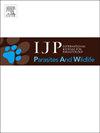野生保护野牛群和共放牧牛的内马比组元条形码分析显示了不同的物种组成和低水平的苯并咪唑抗性
IF 2.2
3区 医学
Q3 ECOLOGY
International Journal for Parasitology-Parasites and Wildlife
Pub Date : 2025-09-05
DOI:10.1016/j.ijppaw.2025.101134
引用次数: 0
摘要
胃肠道线虫(GIN)生活在北美平原野牛(bison bison)的复杂群落中,bison bison是北美草原生态系统的基石有蹄类物种。这些毛线虫种类的致病性水平各不相同,可引起从亚临床到临床的各种疾病。然而,北美野牛的物种多样性和分布尚未得到充分研究,特别是在美国的保护群中。2022年,研究人员从6个保护野牛群中收集了粪便样本,并于2023年在6个州(科罗拉多州、爱荷华州、内布拉斯加州、北达科他州、南达科他州、俄克拉荷马州)对其中5个野牛群进行了重新采样。与俄克拉荷马州的一群野牛共食的一群长角牛的粪便样本也在两年内被收集。通过粪卵计数和共育,对第三期幼虫进行ITS2 rDNA metabarcoding处理,确定其种类组成,并筛选同种型-1 β-微管蛋白基因的200Y (TTC >; TAC)多态性,以评估其对苯并咪唑的抗性。利用Shannon多样性指数和逆Simpson多样性指数确定了每个牧群的α多样性。采用Bray-Curtis差异指数对不同牧群间的Beta多样性进行了评价。最常见的三种是血腹chus placei, Ostertagia ostertagi和Cooperia oncophora。寄生物种多样性最高的牧群是俄克拉荷马州、爱荷华州和北达科他州。科罗拉多州的牧群显示出的寄生虫群落多样性最少。在为期两年的研究过程中,在几个保护野牛群中观察到中度至高度的GIN物种多样性。此外,在共放牧的野牛群和牛群之间,确定了不同的寄生虫种类比例。最后,检测到与苯并咪唑耐药相关的200Y (TTC >; TAC)低频率多态性。我们的研究揭示了美国保护野牛群物种多样性和丰富度的差异,并提供了北美野生野牛苯并咪唑抗性标记的第一个证据。本文章由计算机程序翻译,如有差异,请以英文原文为准。

Nemabiome metabarcoding of wild conservation bison herds and co-grazing cattle reveals different species compositions and low-level benzimidazole resistance
Gastrointestinal nematodes (GIN) live in complex communities within American plains bison (Bison bison), a keystone ungulate species of North American prairie ecosystems. These trichostrongylid nematode species vary in their level of pathogenicity and can cause disease ranging from subclinical to clinical. However, the GIN species diversity and distribution of North American bison are understudied, especially in conservation herds in the United States. Fecal samples from conservation bison were collected from six herds in 2022, with five of those herds resampled in 2023 across six states (Colorado, Iowa, Nebraska, North Dakota, South Dakota, Oklahoma). Fecal samples from a herd of longhorn cattle that co-graze with a bison herd from Oklahoma were also collected in both years. Following fecal egg counts and coproculture, third-stage larvae were processed using ITS2 rDNA metabarcoding to determine the trichostrongylid species composition and screened for the 200Y (TTC > TAC) polymorphisms of the isotype-1 β-tubulin gene to assess possible benzimidazole resistance. Alpha diversity was determined for each herd using the Shannon and the inverse Simpson diversity Index. The Beta diversity was assessed between herds using the Bray-Curtis dissimilarity index. The three most common species found were Haemonchus placei, Ostertagia ostertagi, and Cooperia oncophora. The herds with the highest parasite species diversity were in Oklahoma, Iowa, and North Dakota. The herd in Colorado showed the least diverse parasite communities. Over the course of the two-year study, moderate to high GIN species diversity was observed across several of the conservation bison herds. Additionally, different parasite species proportions were determined between co-grazing bison and cattle herds. Lastly, low frequencies of the 200Y (TTC > TAC) polymorphisms, associated with benzimidazole resistance, were detected. Our study reveals differences in species diversity and richness among conservation bison herds across the United States and provides the first evidence of benzimidazole resistance markers in wild bison in North America.
求助全文
通过发布文献求助,成功后即可免费获取论文全文。
去求助
来源期刊

International Journal for Parasitology-Parasites and Wildlife
Medicine-Infectious Diseases
CiteScore
3.80
自引率
5.60%
发文量
113
审稿时长
45 days
期刊介绍:
The International Journal for Parasitology: Parasites and Wildlife (IJP-PAW) publishes the results of original research on parasites of all wildlife, invertebrate and vertebrate. This includes free-ranging, wild populations, as well as captive wildlife, semi-domesticated species (e.g. reindeer) and farmed populations of recently domesticated or wild-captured species (e.g. cultured fishes). Articles on all aspects of wildlife parasitology are welcomed including taxonomy, biodiversity and distribution, ecology and epidemiology, population biology and host-parasite relationships. The impact of parasites on the health and conservation of wildlife is seen as an important area covered by the journal especially the potential role of environmental factors, for example climate. Also important to the journal is ''one health'' and the nature of interactions between wildlife, people and domestic animals, including disease emergence and zoonoses.
 求助内容:
求助内容: 应助结果提醒方式:
应助结果提醒方式:


